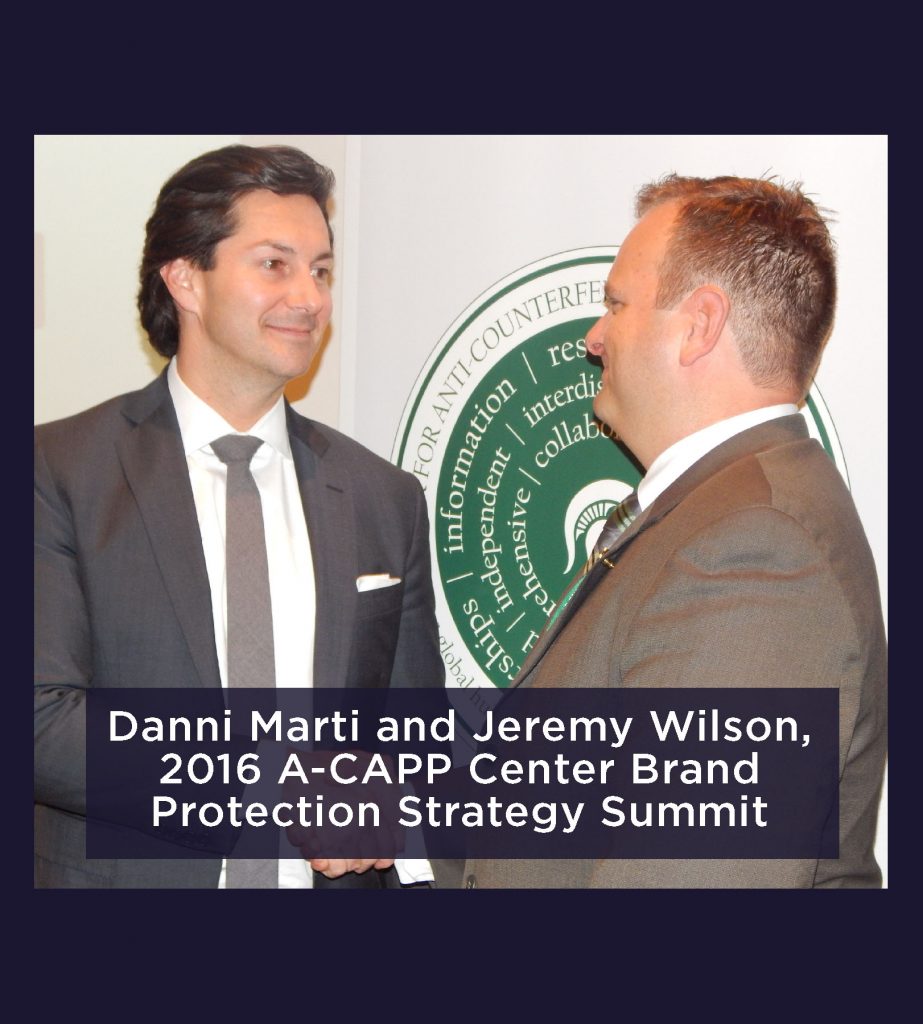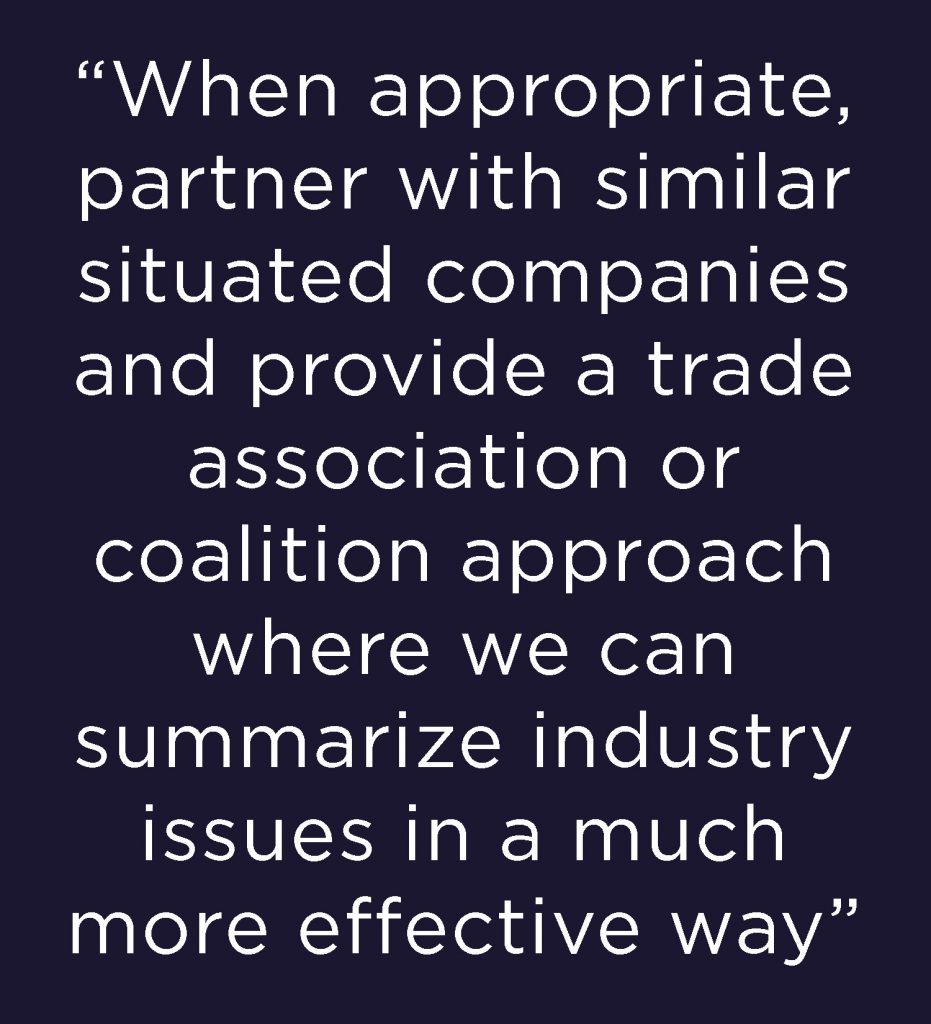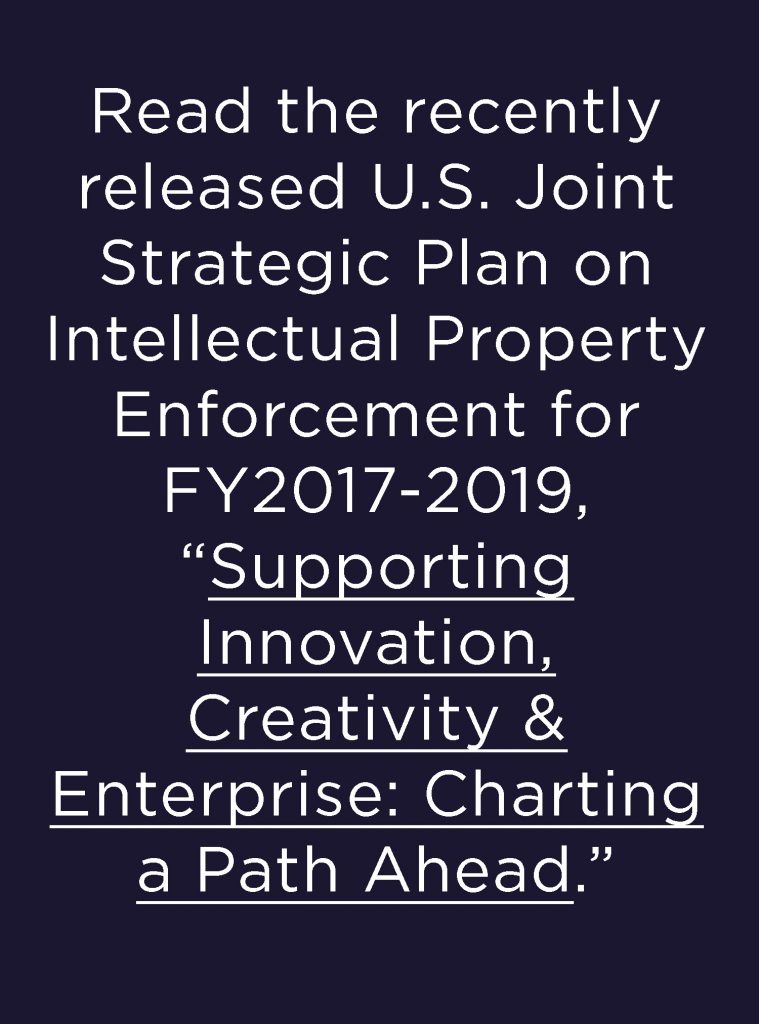Jeremy Wilson
Director, Center for Anti-Counterfeiting and Product Protection, and Professor, School of Criminal Justice, Michigan State University

As the Intellectual Property Enforcement Coordinator (IPEC) within the Executive Office of the President of the United States, Danny Marti leads efforts to develop a strategic plan on the enforcement of intellectual property rights and is responsible for coordinating efforts of federal agencies engaged in intellectual property policy and enforcement. Marti agreed to an interview with Dr. Jeremy Wilson, Director of the Center for Anti-Counterfeiting and Product Protection (A-CAPP) at Michigan State University, at the 2016 A-CAPP Center Brand Protection Strategy Summit.
Jeremy Wilson: Can you say a few words about the IPEC office and its mission?
Danny Marti: The PRO-IP Act of 2008 created the Office of the Intellectual Property Enforcement Coordinator and placed it in the Executive Office of the President. Congress had realized a number of federal departments, offices, and agencies all had intellectual-property equities. Congress formalized this coordinator position to help the federal government think past the formal lines of one department’s work plans to provide a whole-of-government approach.
Wilson: How have you seen the office change over the past several years?
Marti: Since arriving at IPEC, we now have two career staff, including a professional chief of staff, who will help provide continuity into the next administration. In addition, we have brought-on a number of detailees (government employees from other departments or offices) to work in my office for a period of time. The office needs to have a level of institutionality and capacity in order to continue its mandate. So I wanted to focus sufficient time to building up of the institution so that I can work to pass it to the new administration while also taking very seriously one of our statutory deliverables, which is the joint strategic plan.
Wilson: What parts of your mission do you think the office is currently doing very well?
Marti: We have been quite extensively engaged in the international space to heighten awareness of the convergence of threats in illicit trade. I think we need to understand and talk about the issues quite differently than we have in past. Sometimes you hear about IP being spoken in terms of protection, and I think that’s shorthand speak for all of us. We’re protecting X brand. The truth of the matter is it’s about integrity of supply chains around the world and about the diversity of counterfeit products that exists in global markets. So what we’ve been attempting to do over the last year or year and a half is to increase the understanding of our trading partners around the world on the nature of the threat we’re facing in order to obtain the collaboration and partnerships we need to address this truly global threat.
Wilson: What areas do you think need special attention moving forward?

Marti: There’s the macro, big-picture policy issues, and there’s the micro, agency-level issues of what needs to be done with respect to federal government engagement. At the macro level, one thing that I’ve been discussing with our international partners is the need to develop a whole-of-government approach as well as a specialized approach to IP crimes, illicit trade, and pirated goods. Most countries around the world do not have a whole-of-government approach to combat counterfeit goods. Let me dissect that for a moment. In the U.S., we take a whole-of-government approach from a strategy standpoint and from an operational standpoint. From a strategic standpoint, my office does not do actual operations but we provide the policy environment, the strategy setting. We work across two dozen federal partners to develop this strategy, that provides a whole-of-government approach that is greater than [that] of any one particular partner. On the operational side we have the IPR Center—Bruce Foucart is a liaison to your Center’s board and has been a wonderful leader and partner in the fight against illicit trade. He runs a great shop at the IPR Center. The IPR Center is a perfect example of an operational whole-of-government approach. They bring together 19 domestic and four international partners in a task-force setting to combat this global threat. Very few countries have any models like this. I think we need to do more of that in order to make the world a smaller place where law enforcement, companies, and other stakeholders can work across geographic lines to combat this truly global threat.
Wilson: What do you see as some of the biggest challenges in bringing partners together to create a shared vision?
Marti: Our trading partners understand the threat, and are interested to do more and partner more. I think some of the challenges may be a lack of resources and competing priorities, as we all have. And that’s where our dedicated focus to keep moving forward is important.
Wilson: How does it work practically to involve brand owners in what you’re doing? Obviously you have finite resources and there are many companies out there. How do you go about coordinating among them? What can they do to get involved in your strategy setting?
Marti: A few things. Last fall, I issued a Federal Register notice and we accepted comments from anyone who wanted to submit them regarding development of the next national three-year plan. And we received several comments from the private sector. We’ve also maintained an open-door policy for companies and other stakeholders who want to speak with me or my team. I also engage with the private sector (in conferences, international fora, at the IPR Center, and with other federal partners) to understand the nature of the threats that they’re facing. It is difficult because there’s many of them, so one thing that I have encouraged rights holders to do is to develop a summary of the threats and the limitations that they’re seeing and share with us some ideas, some best practices. When appropriate, partner with similar situated companies and provide a trade association or coalition approach where we can summarize industry issues in a much more effective way. One example is with the automotive industry. We could have, and have, heard from individual car manufacturers. But sometimes it’s more effective when they all come together. I think where the government can weigh in are on those issues that are more cross-cutting and global in nature, where an individual company or trade association may find it difficult to gain traction.
Wilson: Are there things your office does that influence what’s being done in other countries?
Marti: The federal government responds quite forcefully to these countries that are not living up either to their international treaty obligations or are engaging in unfair and deceptive trade practices. Putting that public pressure on companies and entities that engage in disproportionate illicit trade is important to get the message out and see if we can drive behavior.
Wilson: So many of our brand-protection partners struggle internally, particularly with their senior leadership, to explain the importance and value of brand protection. If you were in their position, how would you argue the importance of protecting brands and intellectual property?
Marti: I think too often we address the nature of counterfeiting as a single-dimension threat that perhaps undermines the company’s bottom line. It could affect brand value, it could represent lost sales, etc. What we often don’t discuss publicly are the additional convergences of threats that illicit trade represents. Illicit trade and pirated goods also pose significant risks to public health and safety. The consuming public does not appreciate how diverse counterfeit trade looks like today. When a consumer and sometimes a policy official closes his or her eyes and thinks about what counterfeit trade looks like, they may conjure up images of counterfeit luxury purses or sunglasses or luxury watches but little do they know that Customs and Border Protections sees counterfeit products in over 600 diverse product categories, from contact lenses to toothpaste to children’s toys to electronics to all sorts of apparel, footwear, accessories. The breadth is amazing. Anything that can be faked is being faked. We are seeing increased counterfeit trade in pesticides and fertilizers that are poisoning farmlands across the world and possibly poisoning the food that ends up on our dinner plates.
Wilson: What do you think is the most important message to get across to consumers about this issue?
Marti: Consumers need to appreciate the multi-dimensional nature of counterfeit goods. Too often a consumer may see a counterfeit bag or other product in the single dimension of an economic transaction and don’t appreciate the bag might have been manufactured through child or forced labor or contributed to environmental damage at the source of manufacture or maybe distributed through transactional organized crime networks. The consumer does not see the bigger picture, and that’s one thing that government as well as academia and other stakeholders can help provide a deeper understanding as to the convergence of threats posed by illicit trade.
Wilson: What can academia do to help reduce IP crime?
Marti: This space needs to have more rigor in its analytical assessments. There is very little data and scholarly research on a number of these topics. Academia can help develop the framework to understand these threats. Let me return to the labor conditions. I’m not aware of any definitive report in the U.S. or elsewhere that either seeks to quantify or fully develop our understanding of labor conditions associated with the manufacture of counterfeit goods. There are a number of reports that will talk about child labor and forced labor but the subset of those exploited labor categories in connection with the manufacture of counterfeit goods is an area where we’re missing research. We’re missing understanding. And I think we need to have that type of understanding in order to find effective solutions. If, for example, we realize labor conditions associated with the manufacture of counterfeit trade often implicates either forced labor, child labor, unsafe working conditions, or some other categories, we can direct our efforts in the labor space to also focus a solution on the illicit trade space. But right now we address them in a highly compartmentalized manner.
Wilson: Is there anything else that you’d like to share with our partners about you or your office or brand protection?
Marti: I think we might have touched upon it, but the importance of having data-driven strategies. That’s where we need collaboration between rights holders, who have their own body of information, what they’re seeing in the field, with government partners, who might be exposed to some additional data points both domestically and globally, and academic institutions, to provide the level of research and strategy behind what we’re all doing. We need to pool all these different sources if we’re going to find a more effective response to illicit trade.
THE BRAND PROTECTION PROFESSIONAL |DECEMBER 2016 | VOLUME 1 NUMBER 2
2016 COPYRIGHT MICHIGAN STATE UNIVERSITY BOARD OF TRUSTEES

